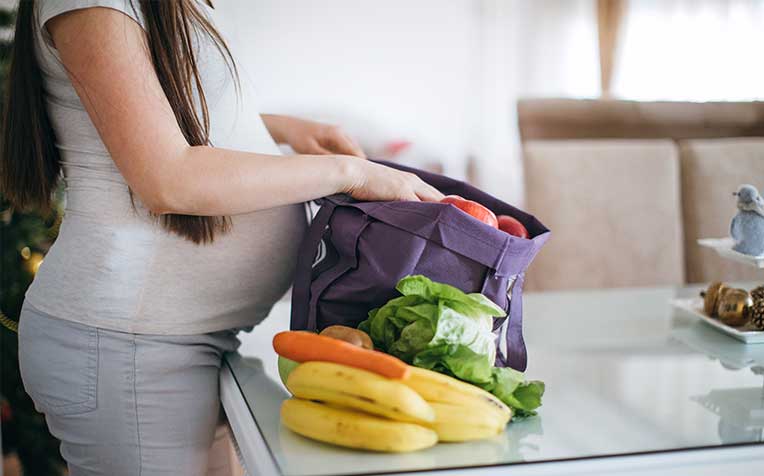
Changing your diet is usually the first method of treatment for gestational diabetes mellitus.
Treatment for gestational diabetes mellitus (GDM)
Gestational diabetes mellitus (GDM) usually improves with lifestyle measures such as:
- Healthy eating, and
- Exercise
"Despite best efforts at lifestyle modification, some women need to take tablets or insulin injections to control their glucose levels. If insulin therapy is required, the technique for self-injection will be taught," explains Dr Lim Wei Ying, Associate Consultant from the Department of Endocrinology, Singapore General Hospital (SGH), a member of the SingHealth group.
You may also be referred to a doctor who specialises in diabetes for further monitoring during your pregnancy.
What to expect during antenatal visits
Your blood pressure and urine will be checked at every visit as you have an increased risk of developing pre-eclampsia (high blood pressure condition that develops only during pregnancy).
Ultrasound scans will be performed to monitor your baby’s growth closely. Regular blood tests will also be performed to monitor your blood glucose control.
Individualised advice about the timing and type of delivery will also be given to you by the specialist team at an appropriate time. These depend on various factors such as the blood glucose control, size of the baby, blood pressure measurements and previous surgeries, etc.
What to expect during labour
It is essential for blood glucose levels to be controlled at a satisfactory level. Blood glucose levels will be measured every hour and some women may require an insulin drip for optimal glucose control.
What to expect after delivery
Breastfeeding is encouraged after delivery.
Can diet help treat gestational diabetes mellitus?
Changing your diet is usually the first method of treatment for gestational diabetes.
Your caloric requirements and needs during pregnancy will be tailored specifically for you and will depend on several factors such as:
- Stage of pregnancy
- Pre-pregnancy weight and BMI
- Rate of weight gain during pregnancy
- Activity levels
- Blood glucose levels
A healthy balanced diet is recommended to help you achieve optimal glucose control while ensuring that there is adequate nutrition to support you and your baby’s growth.
Important nutrients for a healthy pregnancy
Some nutrients become particularly important at this stage, namely:
Folic acid
Folic acid is found in green leafy vegetables, yeast and meat extracts, citrus fruits and juices (e.g. oranges), beans and fortified foods like cereals.Iron
Iron is found in liver, meat, fish, beancurd, wholegrain cereals, green leafy vegetables and eggs. There are 2 types of iron – haem iron and non-haem iron.Haem iron comes from animals and is found in:
- Red meat
- Poultry (chicken, duck, etc)
- Fish and seafood
- Liver
Please limit liver consumption to no more than 50 g per week in the first trimester as excessive intake of vitamin A in the first trimester can lead to birth defects.
Non-haem iron is found in plants and iron-fortified foods such as:
- Green leafy vegetables
- Beancurd
- Wholegrain cereals
Vitamin C helps your body absorb non-haem iron better.
Benefits of iron intake during pregnancy
Iron helps:
- Prevent anaemia, a condition of insufficient red blood cells in the blood
- Your baby build up his iron stores, to last for the first 6 months of his life
Calcium
During pregnancy, you should take 1,000 mg of calcium a day:- For the development of your baby's teeth and bones
- To maintain your own calcium stores
"It is essential that you meet your requirements of these nutrients at every stage of your pregnancy," says Ms Kala Adaikan, Senior Principal Dietitian from the Department of Dietetics, Singapore General Hospital, a member of the SingHealth group.
In addition, from the second trimester, you will also be required to consume:
- Additional calories
- Additional protein to support the baby’s growth in the second and third trimester
This however needs to be individualised and apportioned with caution based on:
- The rate of weight gain
- Blood glucose profile
- Eating pattern
Carbohydrate intake
It is recommended that you learn to:
- Estimate the quantity of carbohydrate per serving and per meal/snack
- Learn to select the type of carbohydrate that will contribute to optimal post-meal glucose control
Speak to your doctor about a referral to a dietitian for an individualised education and counselling session.
Ref: O17

















 Get it on Google Play
Get it on Google Play